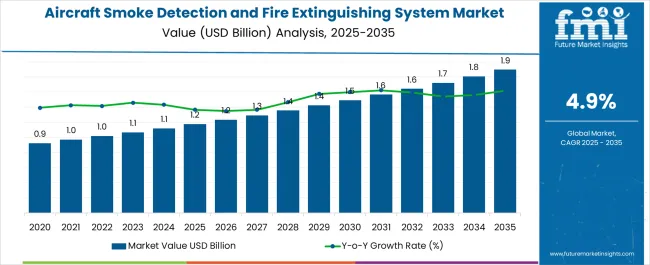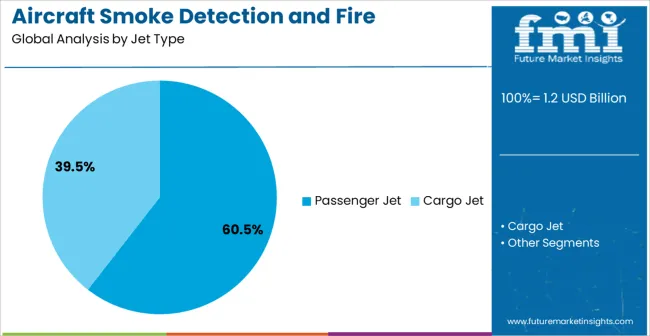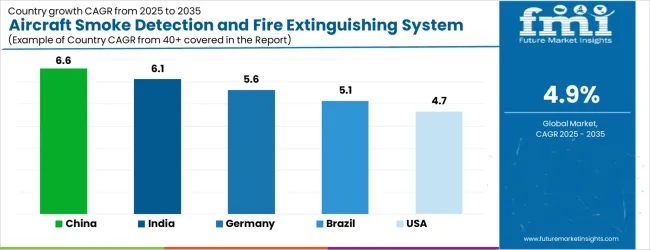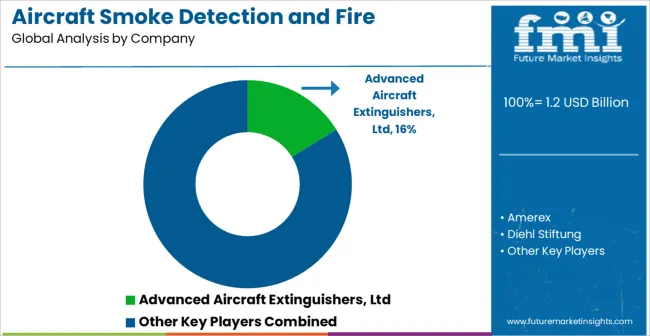The Aircraft Smoke Detection and Fire Extinguishing System Market is estimated to be valued at USD 1.2 billion in 2025 and is projected to reach USD 1.9 billion by 2035, registering a compound annual growth rate (CAGR) of 4.9% over the forecast period.

| Metric | Value |
|---|---|
| Aircraft Smoke Detection and Fire Extinguishing System Market Estimated Value in (2025 E) | USD 1.2 billion |
| Aircraft Smoke Detection and Fire Extinguishing System Market Forecast Value in (2035 F) | USD 1.9 billion |
| Forecast CAGR (2025 to 2035) | 4.9% |
The Aircraft Smoke Detection and Fire Extinguishing System market is growing steadily as aviation safety regulations become increasingly stringent and airlines place greater emphasis on passenger safety and operational reliability. The rise in global air traffic, supported by both commercial and private aviation, has heightened the importance of robust detection and extinguishing systems to mitigate fire-related risks. Technological advancements such as intelligent smoke sensors, real-time monitoring systems, and advanced suppression agents are improving response times and operational efficiency.
The market is also benefiting from the adoption of lightweight materials and compact designs that help reduce overall aircraft weight while maintaining compliance with safety standards. Growing investments in fleet modernization programs, coupled with regulatory mandates from aviation authorities, are accelerating adoption across both new aircraft and retrofitting projects.
With airlines seeking cost-effective safety solutions that minimize downtime and meet international standards, the Aircraft Smoke Detection and Fire Extinguishing System market is positioned for sustained growth The integration of predictive maintenance and smart monitoring is expected to further expand adoption in the coming decade.
The aircraft smoke detection and fire extinguishing system market is segmented by jet type, and geographic regions. By jet type, aircraft smoke detection and fire extinguishing system market is divided into Passenger Jet and Cargo Jet. Regionally, the aircraft smoke detection and fire extinguishing system industry is classified into North America, Latin America, Western Europe, Eastern Europe, Balkan & Baltic Countries, Russia & Belarus, Central Asia, East Asia, South Asia & Pacific, and the Middle East & Africa.

The passenger jet type segment is projected to hold 60.5% of the market revenue share in 2025, making it the dominant aircraft type for smoke detection and fire extinguishing systems. This leadership is being driven by the rapid increase in global passenger traffic, which is creating strong demand for enhanced onboard safety measures. Passenger jets require extensive smoke detection and fire suppression systems to protect both cabin and cargo areas, where risks are heightened due to passenger density and storage of goods.
The need for compliance with stringent international aviation safety regulations is reinforcing adoption of advanced systems in this segment. Airlines are prioritizing fire safety solutions that combine accuracy, speed of detection, and lightweight design to maintain operational efficiency while ensuring passenger protection.
Continuous innovation in multi-zone smoke sensors and eco-friendly extinguishing agents is further improving system effectiveness As global fleets expand, especially in emerging markets, the passenger jet segment is expected to remain the largest contributor, driven by the dual focus on passenger safety and regulatory compliance.
Taking into consideration the global significance of air transport for achieving high speed of global communication, transportation and connectivity, the aircraft smoke detection and fire extinguishing system have been of major significance from multiple viewpoints of improved air safety, aircraft management and superior features for enhanced experience.
The number of passengers who opt to travel through airlines is increasing and hence narrow bodies of jets having higher passenger carrying capacity need to have a reliable fire protection system. Stringent rules and regulations being executed by the aviation regulatory bodies globally is also expected to propel the growth of the global aircraft smoke detection and fire extinguishing system market over the estimated period.
The prominence of the endowment of superior aircraft smoke detection and fire extinguishing system for aircraft carriers worldwide becomes highly authoritative to ensure comfortable and safe journey. Furthermore, the advancement in the features of aircraft smoke detection and fire extinguishing system technology with the introduction of sensors and other advanced technologies is making it more attractive to be the consumer’s first choice in the global market.
The demand for superior and advanced aircraft smoke detection and fire extinguishing systems is expected to drive the global aircraft smoke detection and fire extinguishing system market over the estimated period. Manufacturers have launched sensors that detect fire by the carbon monoxide released from it giving the exact allocation of the fire.
Coupling of such sensors with the aircraft smoke detection and fire extinguishing system is expected to propel the market value share over the estimated period.

| Country | CAGR |
|---|---|
| China | 6.6% |
| India | 6.1% |
| Germany | 5.6% |
| Brazil | 5.1% |
| USA | 4.7% |
| UK | 4.2% |
| Japan | 3.7% |
The Aircraft Smoke Detection and Fire Extinguishing System Market is expected to register a CAGR of 4.9% during the forecast period, exhibiting varied country level momentum. China leads with the highest CAGR of 6.6%, followed by India at 6.1%. Developed markets such as Germany, France, and the UK continue to expand steadily, while the USA is likely to grow at consistent rates. Japan posts the lowest CAGR at 3.7%, yet still underscores a broadly positive trajectory for the global Aircraft Smoke Detection and Fire Extinguishing System Market. In 2024, Germany held a dominant revenue in the Western Europe market and is expected to grow with a CAGR of 5.6%. The USA Aircraft Smoke Detection and Fire Extinguishing System Market is estimated to be valued at USD 422.7 million in 2025 and is anticipated to reach a valuation of USD 422.7 million by 2035. Sales are projected to rise at a CAGR of 0.0% over the forecast period between 2025 and 2035. While Japan and South Korea markets are estimated to be valued at USD 63.1 million and USD 34.7 million respectively in 2025.

| Item | Value |
|---|---|
| Quantitative Units | USD 1.2 Billion |
| Jet Type | Passenger Jet and Cargo Jet |
| Regions Covered | North America, Europe, Asia-Pacific, Latin America, Middle East & Africa |
| Country Covered | United States, Canada, Germany, France, United Kingdom, China, Japan, India, Brazil, South Africa |
| Key Companies Profiled | Advanced Aircraft Extinguishers, Ltd, Amerex, Diehl Stiftung, Fire Fighting Enterprises (FFE), Gielle, H3R, Meggitt, Siemens, UTC Aerospace Systems, and Ventura Aerospace |
The global aircraft smoke detection and fire extinguishing system market is estimated to be valued at USD 1.2 billion in 2025.
The market size for the aircraft smoke detection and fire extinguishing system market is projected to reach USD 1.9 billion by 2035.
The aircraft smoke detection and fire extinguishing system market is expected to grow at a 4.9% CAGR between 2025 and 2035.
The key product types in aircraft smoke detection and fire extinguishing system market are passenger jet and cargo jet.
In terms of , segment to command 0.0% share in the aircraft smoke detection and fire extinguishing system market in 2025.






Our Research Products

The "Full Research Suite" delivers actionable market intel, deep dives on markets or technologies, so clients act faster, cut risk, and unlock growth.

The Leaderboard benchmarks and ranks top vendors, classifying them as Established Leaders, Leading Challengers, or Disruptors & Challengers.

Locates where complements amplify value and substitutes erode it, forecasting net impact by horizon

We deliver granular, decision-grade intel: market sizing, 5-year forecasts, pricing, adoption, usage, revenue, and operational KPIs—plus competitor tracking, regulation, and value chains—across 60 countries broadly.

Spot the shifts before they hit your P&L. We track inflection points, adoption curves, pricing moves, and ecosystem plays to show where demand is heading, why it is changing, and what to do next across high-growth markets and disruptive tech

Real-time reads of user behavior. We track shifting priorities, perceptions of today’s and next-gen services, and provider experience, then pace how fast tech moves from trial to adoption, blending buyer, consumer, and channel inputs with social signals (#WhySwitch, #UX).

Partner with our analyst team to build a custom report designed around your business priorities. From analysing market trends to assessing competitors or crafting bespoke datasets, we tailor insights to your needs.
Supplier Intelligence
Discovery & Profiling
Capacity & Footprint
Performance & Risk
Compliance & Governance
Commercial Readiness
Who Supplies Whom
Scorecards & Shortlists
Playbooks & Docs
Category Intelligence
Definition & Scope
Demand & Use Cases
Cost Drivers
Market Structure
Supply Chain Map
Trade & Policy
Operating Norms
Deliverables
Buyer Intelligence
Account Basics
Spend & Scope
Procurement Model
Vendor Requirements
Terms & Policies
Entry Strategy
Pain Points & Triggers
Outputs
Pricing Analysis
Benchmarks
Trends
Should-Cost
Indexation
Landed Cost
Commercial Terms
Deliverables
Brand Analysis
Positioning & Value Prop
Share & Presence
Customer Evidence
Go-to-Market
Digital & Reputation
Compliance & Trust
KPIs & Gaps
Outputs
Full Research Suite comprises of:
Market outlook & trends analysis
Interviews & case studies
Strategic recommendations
Vendor profiles & capabilities analysis
5-year forecasts
8 regions and 60+ country-level data splits
Market segment data splits
12 months of continuous data updates
DELIVERED AS:
PDF EXCEL ONLINE
Marine Fire Extinguishing System Market Size and Share Forecast Outlook 2025 to 2035
Wireless Fire Detection Systems Market Analysis - Size, Growth, and Forecast 2025 to 2035
Fire Alarm Systems Market by Solution by Application & Region Forecast till 2035
Fire Hydrant System Market Trends – Demand, Innovations & Forecast 2025 to 2035
Aircraft Fuel Systems Market Size and Share Forecast Outlook 2025 to 2035
Aircraft Fuel System Market
Fire Sprinkler System Market Size and Share Forecast Outlook 2025 to 2035
Aircraft Galley Systems Market Size and Share Forecast Outlook 2025 to 2035
Fire Protection System Pipes Market Size and Share Forecast Outlook 2025 to 2035
Fire Protection Systems for Industrial Cooking Market Growth - Trends & Forecast 2025 to 2035
Aircraft Oxygen System Market
Fire Suppression System Market Size and Share Forecast Outlook 2025 to 2035
Aircraft Washing Systems Market Analysis - Size, Share & Forecast 2025 to 2035
Aircraft Braking System Market
Aircraft Exhaust System Market
Ice Detection System Market Trends, Growth & Forecast 2025 to 2035
Aircraft Hydraulic System Market Analysis Size Share and Forecast Outlook 2025 to 2035
Bird Detection System Market Size and Share Forecast Outlook 2025 to 2035
Fall Detection System Market Insights – Size & Forecast 2025 to 2035
Aircraft Sequencing System Market Growth – Trends & Forecast 2018-2027

Thank you!
You will receive an email from our Business Development Manager. Please be sure to check your SPAM/JUNK folder too.
Chat With
MaRIA